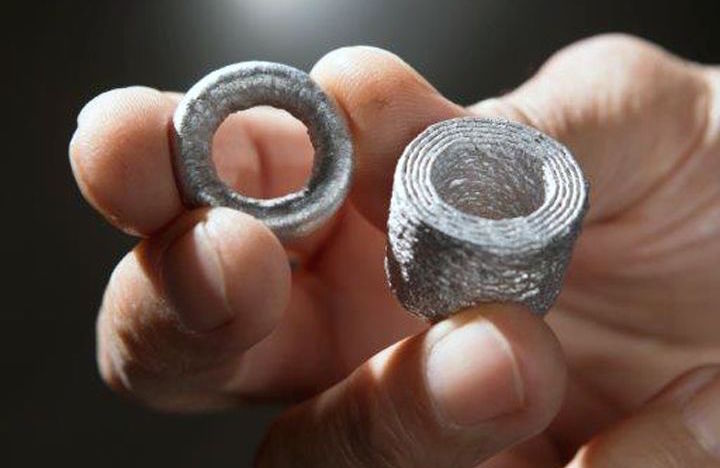
“VADER’S printing technology is a game changer for cost-effective, low-volume production of aluminum components,” said Michael Becker, CEO of BECKER. “It aligns with our goal to deliver shorter lead times and higher performance for our customers.”
MagnetoJet Technology
Traditional additive manufacturing of metal involves laying a layer of powdered metal down and melting it with a laser or electron beam. In order to increase the speed of production, additional laser are used which increases costs. Furthermore, the process can create components with weak spots, as some particles of the powder are not melted.
With technical support from University at Buffalo, Zachary Vader, chief innovation officer and co-founder of Vader Systems, developed the MagnetoJet technology process, which melts metal wire and uses electromagnetic propulsion to produce precision droplets of molten aluminum on-demand.
In the machine, a strand of aluminum is fed into a heating element that melts it at 750°Celsius (1,382°Fahrenheit). Once liquified, the metal is passed to a ceramic tube that forms an ejection chamber with a sub-millimeter nozzle. This tube is surrounded by a magnetic coil that receives a short electrical pulse, creating pressure that ejects a droplet of liquid metal through the nozzle. The ejected drop is projected onto a heated platform that maneuvers to create solid 3-D shapes based on layer-by-layer deposition and the coalescence of the droplets.
Prof. Edward P. Furlani in University at Buffalo’s Chemical and Biological Engineering and Electrical Engineering departments, said that Vader’s process mimics drop-on-demand inkjet printing. “It’s a transformative technology,” said Furlani. “It’s very exciting interdisciplinary engineering. I think its application base will continue to broaden and expand for the foreseeable future.”
Because the MagnetoJet technology uses standard aluminum wire (currently prints with 4043 aluminum, with 6061 and 7075 aluminum alloys under development) instead of metal powder, the Mk1 machine is able to deliver a ten-fold decrease in material costs. Furthermore, the process produces a dense part without the need for lengthy post-processing. The reduced costs combined with increased production rates have the potential to expand the market for additive manufacturing, as shown with the new equipment order from BECKER.
“An important part of my vision in developing this technology was to impact the automotive industry,” said Zachary Vader. “I’m thrilled that a company of BECKER’s caliber has recognized this potential and is choosing to integrate the Mk1 into their manufacturing process.”
Scott Vader, president and co-founder of Vader Systems, adds, “We are excited that our liquid metal 3D printing process will be used to enhance the exceptional value Becker already delivers to its customers, and we look forward to a long and productive collaboration with the BECKER team.”
BECKER will begin to integrate the Mk1 system into its manufacturing process at its new plant in Wixom, Michigan, plant in the first quarter of 2018, with plans to add a second system at their Germany headquarters in late 2018.
